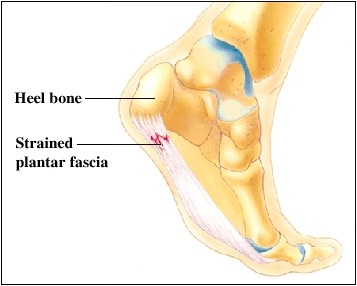Plantar Fasciitis / Plantar Heel Pain
What is it?
Plantar fasciitis is pain on the bottom part of the heel. It is usually an overuse injury that causes inflammation of the plantar fascia at its attachment site on the heel bone.
How does it happen?
Plantar fasciitis occurs because of stretching or ‘pulling’ of the plantar fascia and compression of its attachment on the heel bone. Activities such as running based sports and dancing as well as occupations where you are required to walk and stand a lot are commonly associated with the development of plantar fasciitis. This injury is called an overuse injury; it may happen over a long period of time before the patient decides to seek treatment.
How does it feel?
The pain is typically worse in the morning, with the first steps being very tender until the area warms up. Pain is worse with high impact weight-bearing activities. The site of tenderness is localized to the inside aspect of the heel and is usually described as a dull ache. Over time, combined with the repetitive nature of running or walking, the inflammation can get worse and the intensity of the pain increases.
What should you do?
If you have or suspect you have plantar fasciitis then you should seek treatment as soon as possible. The earlier this injury is treated, the more successful the outcomes. Conservative management is indicated in the form of ice, massage, stretching, footwear modification, heel cushioning, strapping and foot orthoses.
What shouldn’t you do?
You shouldn’t put up with the pain in the hope it will go away. The injury is deceptive in that it warms up and you can walk and run on the area. Unfortunately, each time you run on it you are causing more problems. With time, the pain will not warm up and your injury is far harder to treat and may take longer to respond to conservative treatment.
Could there be any long-term effects?
There could be long-term problems with chronic pain in the area. A heel spur can develop secondary to the plantar fasciitis. More importantly, however, the inflammation can become chronic and may require an injection of cortisone (anti-inflammatory drug), or a surgical opinion.
Management
Sports podiatry assistance is important in the diagnosis and management of plantar fasciitis. An accurate diagnosis is necessary to ensure successful management outcomes. This may include radiological examinations, either X-ray or ultrasound.
It is important to rule out other possible differential diagnoses which affect this area of the heel. Once the extent of the injury is established, a treatment plan can be prescribed. The treatment involves a combination of therapies, as well as assessment and correction of biomechanical anomalies which may have caused the injury.
Footwear assessment and orthoses are also important in the successful treatment of plantar fasciitis. Your Podiatrist will also be able to aid in the return to activity program to prevent re-occurrence of the injury.
Location
56 Zahel St, Carina QLD 4152



